Mobile Homes @ Asian Civilisations Museum

We were at the Asian Civilisations Museum yesterday, marking my second visit to the museum at Empress Place. Currently they have an exhibition that showcases the mobile tents and shelters of Asian nomads.

From my first visit to the museum, I remember it as being both visually and structurally appealing. The exhibits and artefacts sprawl three levels, with many stations that play videos pertaining to the exhibits. There was even a video projection on the floor that I thought was rather creative!

Moving on to the artefacts, I used to think that ancient Chinese emperors wore only yellow garments. But there was a particular cloak, adorned with clouds and dragons, in snow white colour! It looked huge too.

This monumental Buddha was missing its torso. It came from the 1368-1644 time period.
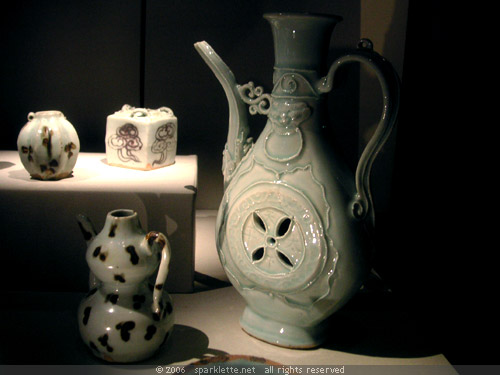
The porcelain ewer, or pitcher, came from the yuan period (1279-1368). It was beautifully crafted and incised with Chinese characters, 天下太平 (world peace). I like it a lot! Despite being so old, it was in pristine condition. With the four decorative holes, how it held any tea or wine is beyond my grasp.

Due to its multiple arms, we thought this guanyin (goddess of mercy) statue from North vietnam looked more like a fusion of Buddhism and Hinduism.

This book that originates from North sumatra in Indonesia contains text that is every bit as potent as it looks. It has magical spells, oracles, medicinal recipes, and instructions for performing rituals and various magic cures. Sounds like pretty lethal stuff!

Moving on, the museum has a huge section dedicated to qur’ans. They come in all forms and sizes and a wide range of colours.

My favourite is this 12th century qur’an from North Africa. The calligraphy is written in gold, and has somehow survived over the centuries. The gold still looks shiny and new! The letters have been accented in dark brown ink to make them more legible.

The script on this qur’an section is also written in gold, and enclosed within cloud designs.
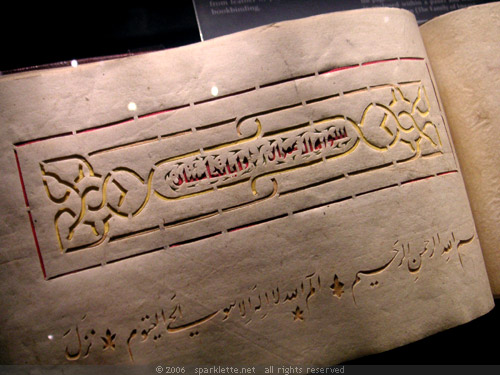
Even more impressive is this particular qur’an manuscript. Instead of being written, the calligraphy has been painstakingly cut out! The aim is to make the cut-off resemble the calligrapher’s handwriting exactly, and requires great skill and precision.
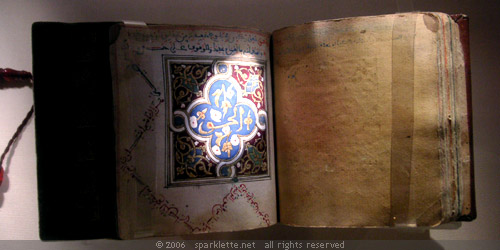
The asma’ al-husna (ninety-nine names of Allah) is considered a source of blessing. Each one has been written onto the centre of a page, and adorned with colourful geometric designs.

This marble tombstone comes from the 9th century. It has been elaborately engraved with Islamic wordings, although elaborate tombstones are traditionally frowned upon.
“All that is gold does not glitter; not all those that wander are lost.”
– J.R.R. Tolkien, The Fellowship of the Ring
The exhibition showcases the dwellings of nomads from central and West Asia.
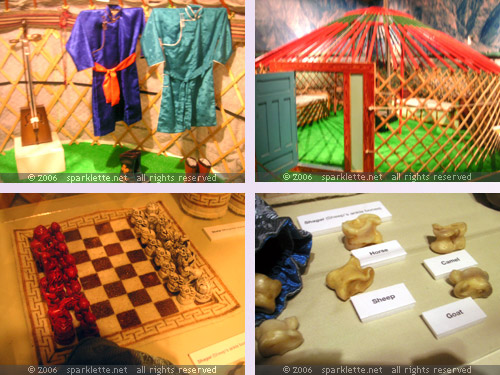
Mongol people were expert horsemen trained to ride from young age. Perhaps the most famous of them all would be Genghis Khan. The mongol yurt is called a ger (pronounced “gair”). At its centre is where the stove would be typically located. The back of the yurt is reserved for the most respected or eldest person.
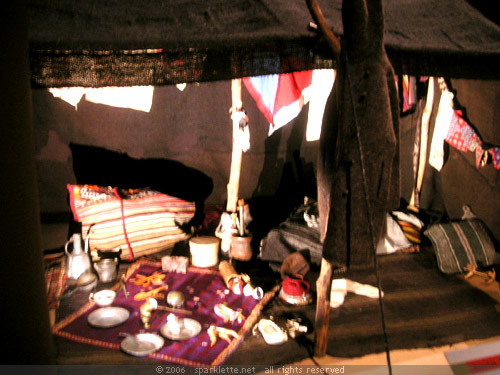
Funnily enough, the Turkish tent does not appear to have any sort of covering over the front, like anyone is free to waltz into the tent any time! It looks as though it can be set up within five minutes.

The turkmen yurt, called the oy, looks the best out of the group. The new ones are called aq oy (white tent) when the felt mats are still clean and white. Eventually they turn black from the smoke of the fire burning within the yurt, and these old tents are then called qara oy (black tent). How cute!
The walls of the yurt are covered with panels of bamboo screens. The entrance is beautifully decorated with multi-coloured woven bands embroidered in different patterns. Within the yurt, there are three sections – one for the women (with the baby cradle, cooking utensils and such), one for the men(with ropes and weapons), and a place of honour that faces the entrance.
Overall, I was largely disappointed by the scale of this exhibition. I had fully expected a huge array of tents that come in various sizes, materials and colours, with different functionalities and perhaps the ways they have changed over the centuries. But there were perhaps just three or four noteworthy tents. The modern tent on loan from NUS’ sports society doesn’t count! For an exhibition spanning three months, it was one of extremely small scale.
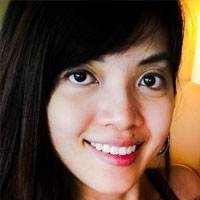
Jun 12, 2006
3
You know, regarding the “All that is gold does not glitter; not all those that wander are lost.” quote, I do believe that it’s something that came out of the movie rather than the book. Lest I’m mistaken…
Jun 12, 2006
3472
I’m not too sure about whether it came from the book or the movie… too lazy to read my Lord of the Rings trilogy boxset! I do think it came from the book though. Don’t recall hearing or seeing that quote in the movie.
“All that is gold does not glitter,
Not all those that wander are lost.
The old that is strong does not wither,
Deep roots are not reached by the frost.
From the ashes a fire shall be woken,
A light from the shadows shall spring.
Renewed shall be (the) blade that was broken,
The crownless again shall be king.”
Jun 12, 2006
1
I also thought that the emporers only wore yellow garments! Now I know that they wear snow white coloured garments as well.
Jun 12, 2006
3472
Haha I guess we learn something new everyday. Gena you are up early!
Jun 12, 2006
1
hi, was actually looking for reviews for giraffe restaraunt from yahoo, then got this link to your review for them in your blog. I am amazed by your blog site. i cannot stop reading, ur interesting girl with interesting interests… enjoy each and everyday of your life, live to the fullest yeah! take care n SMILE
Jun 12, 2006
182
I think I like to ask this question, could you share with me how you manage to take those photos despite the museum’s security watching? Lend me your trade secrets?
Jun 12, 2006
3472
hey jonathan, so glad you found my blog interesting! if you haven’t managed to find my giraffe review, it’s over here. great place and great service, although the main courses were just a-okay.
Jun 12, 2006
3472
py, actually the museum allowed photography. The curator or whoever said photography’s fine as long as there isn’t flash… presumably to protect the artefacts.
I do make it a point to find out a museum’s policy on cameras before I make a trip down.
Jun 13, 2006
hi, i’m a visitor, jus wanna say, your blog is just so beautiful!!!!!
Jun 13, 2006
3472
thank you so much!
Jun 13, 2006
3
say, this post is a good candidate for yesterday. can we post a link to this post?
Jun 13, 2006
3472
it is? i wanted to contribute this to yesterday.sg, but thought it doesn’t really relate to singapore’s heritage.
Jun 13, 2006
3
nobody’s posted anything about the mobile home exhibition yet, plus, it’ll be a good inaugural post!
Jun 13, 2006
3472
done! awaiting approval.
Jun 14, 2006
You took those pictures w/o flash? And yet it looks so clear…the place was pretty dark the other dae I went. Our pics taken w/o flash couldn’t really be seen clearly tho.
Jun 14, 2006
3472
Yeah that was a real problem. All my pictures had to be taken without flash too. Most of them turned out blurry, especially those from the Mobile Homes exhibition.
Jun 26, 2006
2
hi there, I stumble upon your site and I love what you did! I’m a weekend volunteer museum guide with ACM, since you have got so much interest, I tot I’l just share, the white dragon robe you saw at ACM- was meant for the Autumn/Winter Season. Sometimes, it was worn during mourning/funeral too. ;)
Jun 26, 2006
3472
Hi Sharon! Thanks for that juicy nugget of history on the white dragon robe. I bet none of us here knew it until you came along!
You have a great part time job. May I know if the museum needs more volunteers? I would love to help out!
Jun 26, 2006
2
Hey Veron, it ain’t a part-time job. You dun get paid for being a MV. The last I heard, we are the last till 2007 or 8. but you can still drop me a mail and ‘ill fill ya in… but for now, i can only offer to guide you around ACM.
Jun 27, 2006
3472
Yup Sharon I do know it’s a voluntary job and I’m perfectly happy with that. I would get in touch with you soon!